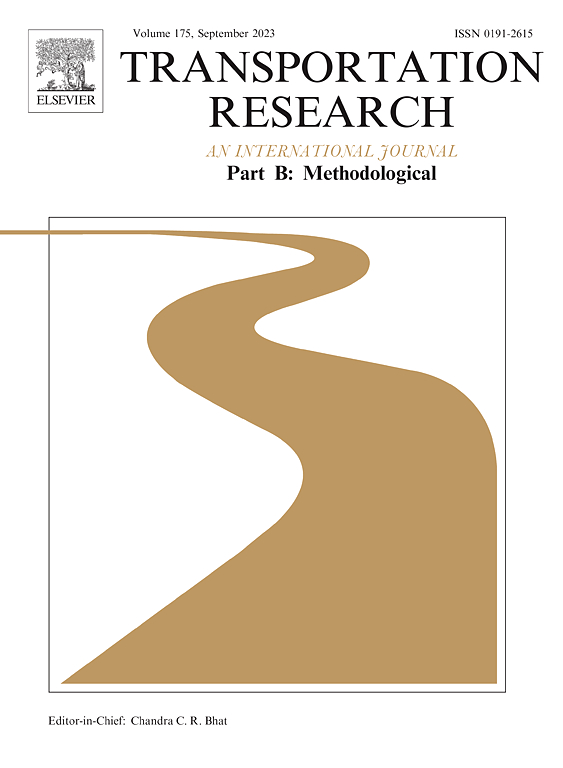Modeling instantaneous queuing effects in the traffic assignment problem with consideration of demand fluctuations in the modeling period
IF 6.3
1区 工程技术
Q1 ECONOMICS
引用次数: 0
Abstract
Instantaneous traffic queues, introducing fluctuated queuing delays, significantly affect the journey times and route choices of travelers particularly during the peak hour periods in congested road networks. Distinguished from average residual queues in static traffic assignment problems, instantaneous queues form and dissipate within minuscule time frames of a modeling period, triggered by an inflow exceeding link capacity, owning to instantaneous demand fluctuations. The inclusion of instantaneous queuing effects is of paramount importance, given their more frequent occurrence compared to residual queues. However, little attention has been given to these instantaneous queuing effects in static traffic assignment models for strategic planning. To fill this gap, this paper proposes a novel instantaneous traffic assignment (ITA) model to incorporate instantaneous queuing effects in congested road networks, accounting for within-period demand fluctuations. The enhanced ITA modeling framework is proposed encompassing two fixed-point problems for network loading and a logit-based stochastic user equilibrium assignment model. The ITA model is formulated as an equivalent variational inequality problem. The mathematical properties of the proposed model such as the stability of the unique solutions can be rigorously proved. An improved method of successive weighted average algorithm with an adaptive step size is developed to solve the proposed model in order to facilitate the examination of instantaneous queuing effects in real-world contexts for large-scale networks. Numerical examples are conducted to demonstrate the merits and efficacy of the proposed ITA model. The feasibility and applicability of the proposed model in reality are further illustrated in case studies of three different road networks.
考虑建模期内需求波动的交通分配问题瞬时排队效应建模
瞬时交通排队,引入波动排队延迟,显著影响旅行时间和路线的选择,特别是在拥挤的道路网络的高峰时段。与静态流量分配问题中的平均剩余队列不同,瞬时队列在建模周期的极短时间框架内形成和消散,由流入超过链路容量触发,由于瞬时需求波动。考虑到瞬时队列比剩余队列更频繁地出现,包含瞬时队列效应是至关重要的。然而,在静态交通分配模型中,对瞬时排队效应的研究很少。为了填补这一空白,本文提出了一种新的瞬时交通分配(ITA)模型,该模型考虑了拥挤路网中的瞬时排队效应,并考虑了周期内需求波动。提出了一种改进的ITA建模框架,该框架包括两个网络加载不动点问题和一个基于逻辑的随机用户均衡分配模型。ITA模型是一个等价变分不等式问题。所提模型的数学性质,如唯一解的稳定性,可以得到严格的证明。提出了一种自适应步长逐次加权平均算法的改进方法来求解该模型,以便于在实际环境中对大规模网络的瞬时排队效应进行检验。通过数值算例验证了该模型的优点和有效性。通过对三种不同路网的实例分析,进一步说明了该模型在现实中的可行性和适用性。
本文章由计算机程序翻译,如有差异,请以英文原文为准。
求助全文
约1分钟内获得全文
求助全文
来源期刊
CiteScore
12.40
自引率
8.80%
发文量
143
审稿时长
14.1 weeks
期刊介绍:
Transportation Research: Part B publishes papers on all methodological aspects of the subject, particularly those that require mathematical analysis. The general theme of the journal is the development and solution of problems that are adequately motivated to deal with important aspects of the design and/or analysis of transportation systems. Areas covered include: traffic flow; design and analysis of transportation networks; control and scheduling; optimization; queuing theory; logistics; supply chains; development and application of statistical, econometric and mathematical models to address transportation problems; cost models; pricing and/or investment; traveler or shipper behavior; cost-benefit methodologies.

 求助内容:
求助内容: 应助结果提醒方式:
应助结果提醒方式:


